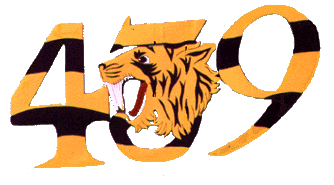|
History
of
 Squadron Squadron
  
Chapter
IV
The
Battle of Normandy
June
- August 1944
Intentionally
left blank.
|
It
was three days before the Squadron was out again; then, on the 29th,
it returned to the battlefront below Caen to blitz enemy strong points
in a group of buildings at St. Martin de Fontenay. No. 439, attacking in
conjunction with No. 438, came down to 1,500 feet in a steep 80o
dive and almost obliterated the target. All but three of the sixteen
buildings in the village were leveled
by the 1,000 lb. bombs. Our own troops, just 500 yards away, were admiring
spectators of the effectiveness of air support.
|
An operation to Laigle, deep in "Indian
country", on the 30th
was of interest because for the first time, so far as Squadron records
indicate, the Tiffie pilots caught sight of enemy aircraft. They were
some distance away, however, and "despite
anxious wishing" did not come near enough to be engaged. (It is
of interest to note that in July the squadrons in Normandy were warned
that the enemy might use a limited number of jet or rocket propelled
aircraft on operations in the near future.) July closed with three
close support attacks in the Caumont area, east
of St. Lo where the Americans had broken through the enemy lines a few
days previously. A Nazi headquarters in a little village received
eight tons of bombs which exploded right in the centre of the target,
demolishing several buildings. The second show was less satisfactory.
The whole Wing had gone out to blast an enemy
concentration
in another village south-east of Caumont where the target, because of
the proximity of our own troops, was to be marked by red smoke shells.
The pilots located the target, despite cloud and haze, and orbited
waiting for the smoke to be laid. After almost 20 minutes had passed
in a grim chase of formation keeping, the Squadrons separated and
bombed alternative targets. No. 439 spread a stick of burst along the
length of a wood and then hurried homeward with anxious eyes on the
fuel gauges. The sortie
had lasted almost 90 minutes. Late
in the evening another load of high explosives was dropped on an enemy
concentration south of Caumont, the aircraft returning to Lantheuil in
the fast gathering dusk.
|
Intentionally
left blank.
|
The British Second Amy expressed its appreciation
of the work that the fighter-bombers did during the last week of July.
Their attacks had been a major factor in preventing the enemy
from moving his armour from the Caen sector to meet the threat in the
west, thereby permitting the American Army and the British 8th Corps to
continue their advance without serious armoured opposition.
  
Copyright ©1998-2016 Michael T. Melnick. All rights reserved the unofficial homepage of  Tiger Squadron Tiger Squadron . . ..
|
|